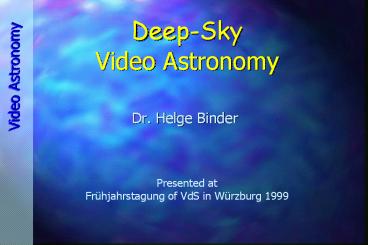Deep-Sky Video Astronomy - PowerPoint PPT Presentation
Title:
Deep-Sky Video Astronomy
Description:
Title: Videoastronomie Author: Dr. Helge Binder Last modified by: Dr. Helge Binder Created Date: 4/13/1999 9:30:14 PM Document presentation format – PowerPoint PPT presentation
Number of Views:248
Avg rating:3.0/5.0
Title: Deep-Sky Video Astronomy
1
Deep-SkyVideo Astronomy
Video Astronomy
- Dr. Helge Binder
Presented at Frühjahrstagung of VdS in Würzburg
1999
2
Principles
Lens/Telescope
Video camera with coupling lens
Frame grabber card
Image intensifier tube
Video Astronomy
AVI file
Single JPEG frames
Processed image
3
Technical Details
Hardware 1. Optics Lens / Telescope 2. Cyclop
10A image intensifier (Russia, 2 Gen.) 3.
Coupling lens 55 mm F/1.4 photo lens (better is
a longer focal length) 4. Video camera Canon MV1
- MiniDV 5. Frame grabber card Miro Video
PCTV 6. Notebook LION 120 P, 40 Mbyte RAM, 1
Gbyte HD with docking
station Software 1. Miro image acquisition
software 2. Main Actor Editor (shareware) 3.
Display 1.83 and CCD Camera software Ver. 1.68
(public domain) 4. Quantum Image Pro 3.5, Astra
Image 1.5, Photoshop 5.0 CorelPaint 8.0
Video Astronomy
4
M42 - Great Orion nebula
70 mm F/1.2 (No guiding - tripod)
Practical Video Astronomy
202 x 1/25s
1/25s
500 mm F/5.6 (No guiding - tripod)
122 x 1/6s
1/6s
5
M42 and Flame nebula
NGT 18 F/4.5 (roughly aligned)
Practical Video Astronomy
78 x 1/6s
1/12s
172 x 1/6s
1/6s
6
Pleiades / h ? Persei
70 mm F/1.2 (No guiding - tripod)
Practical Video Astronomy
252 x 1/25s
1/25s
300 mm F/4.5 (No guiding - tripod)
133 x 1/6s
1/6s
7
M81 and M82
300 mm F/4.5 (No guiding - tripod)
Practical Video Astronomy
525 x 1/6s
1/6s
NGT 18 F/4.5 (roughly aligned)
117 x 1/6s
1/6s
8
M82 and NGC 3628
NGT 18 F/4.5 (roughly aligned)
Practical Video Astronomy
122 x 1/6s
1/6s
223 x 1/6s
1/6s
9
M51 and Rosette nebula
NGT 18 F/4.5 (roughly aligned)
Practical Video Astronomy
315 x 1/6s
1/6s
300 mm F/4.5 (No guiding - tripod)
590 x 1/6s
1/6s
10
Problems
Practical Video Astronomy
760 x 1/6s
960 x 1/6s
1. The left image shows the effect of an unstable
battery. The image intensifier changed the image
scale constantly as the battery current dropped,
producing a zoom effect. 2. The left image shows
an accidental and unrecognized rotation of the
video camera. 3. The image of Rosette nebula, on
the previous page, has a very low S/N ratio . To
obtain an image with a good contrast one should
increase the number of single frames to at least
2000-3000, depending on the image intensifier
tube used.
11
Conclusions
1. Video astronomy allows not only images of
solar system objects, but also deep sky imaging
of low light objects as galaxies and nebulas. 2.
Video imaging can be done with simple tripods,
Dobsons and of course with parallactical
mountings. 3. Take your desired object online,
out of real deep sky session, without disturbing
visual astronomers. 4. RGB images should be
possible. Also high resolution imaging should be
possible with the help of mosaic techniques. 5.
One may video lots of objects in a particular
session - performing image processing during the
many rainy nights and days in Europe. 6. Record
weak stars and minor planets without tracking.
Video Astronomy































